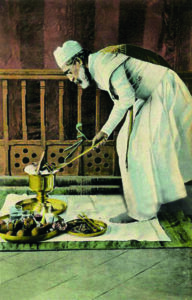Parsi Times presents a 4-part series by Adil J. Govadia, which honours and celebrates our humble Mobeds – our religious heads, who played a crucial role in preserving our Community’s religious and ethnic identity, while keeping aflame our sacred fires, in our temples and in our hearts.

Since antiquity, Zoroastrian priests in Iran have been considered the conscious-keepers of the community, vested with the responsibility of national education and ceremonial commitments. In fact, Zoroastrian Mobeds (priests) were bestowed with authority and reverence that was next only to the Monarch (which can be verified at the museums of London and Berlin, where seals of great priestly luminaries are displayed), indicative of their eminent supremacy.
Even when Zoroastrians had to flee our motherland Iran, it was the humble Mobeds who assumed leadership responsibility to lead a small band of Parsis safely to India. To them goes the entire credit of not only preserving Parsi-Zoroastrian identity, but also of providing authentic scriptural interpretation. Had the Mobeds not maintained and kept the traditional elucidation of the Zoroastrian scriptures, the Parsi community in India would certainly have lost its identity a long time ago, as it happened with other migrant groups from Iran, who, besides migrating to some northern regions of India, also travelled to Europe, China and Ceylon.
Almost all Parsi priests of India draw their origins from Mobed Shapur-Shahriyar, who, along with his two grandsons – Mobed Hormazdyar-Ramyar and Mobed Neryosang Dhaval, make for the original ancestors of all Parsi priests in India. In Sanjan, the revered Mobed Neryosang Dhaval and his followers first studied Sanskrit and then set-up a school of Avesta and Pahlavi studies, which translated ancient manuscripts into Sanskrit, thereby preparing ground for future generations to study, comprehend and follow the time-honored Zoroastrian customs and traditions.
Over the past several centuries, the community produced some of the most noble, morally upright and knowledgeable Mobeds and Dasturs, whose priestly work have remained permanently etched in the annals of Parsi history. One of the first names that comes to mind is that of the great Maghav (spiritually advanced soul) named Aderbad Marespand, the supreme pontiff, who was also the Prime Minister during the reign of Shapur II (309-379 AD) and recognized as the last Raenidar (spiritual redeemer).
According to the Dinkard, Raenidar Aderbad Marespand, because of his profound wisdom, rectitude and spiritually high status, performed miracles like pouring molten metal on his bare chest to demonstrate his manthric powers, with a view to revitalize and re-establish Zoroastrian faith amongst followers. He then set-out to consolidate the scattered fragments of the Avesta to compile them in what is now known as ‘Khordeh Avesta’.
As a Raenidar, he had the mystical and transcendental authority to introduce changes in Zoroastrian religion according to the needs of the New Age, which is now coming to an end, giving way to the next Age of the ensuing Raenidar, named Shah Behram Varzavand, belonging to the Aquarian Age, who apparently will lead the true followers of Zoroastrian religion to a glorious future.
Similarly, mystic Dastur Azar Kaiwan bin Azar Gushasp bin Zardushi, born sometime in mid-16th century in a village near Shiraz (Iran), was a virtuous soul who voluntarily left his abode in Mount Demavand (Iran), with twelve disciples and travelled to Surat and Navsari, before settling in Patna, where he established a spiritual center. It is said that when the great sage declined the invitation of Emperor Akbar to attend the Delhi Darbar, the Emperor opted to personally visit Patna to seek his blessings! Such was his spiritual legacy and mystical greatness. Dastur Azar Kaiwan died in a village called Azimabad, 10 kms from Patna, where his grave and some relics are till date taken care of by a select band of disciples.
The other luminous Parsi mystic was the illustrious Dastur MeherjiRana of Navsari, conferred with the office of first Vada Dastur (high priest) by the Bhagarsath Anjuman of Navsari. According to one account, in 1563, young Meherji, son of Rana-Jesang, was adopted (palak) by his uncle Vatcha. He was not only a disciple of the great mystic saint Dastur Azar Kaiwan of Patna, but also had a commanding and positive influence on the Mughal Emperor – Akbar.
In 1576, Dasturji MeherjiRana was invited to Akbar’s court for religious discussions when he was presented a ‘jagir’ (plot of land) in Navsari, along with several precious gifts of value, as an acknowledgement of the his great sagely acumen! Upon interacting with the holy Parsi sage, Emperor Akbar not only adopted fire as the symbol of holiness in his court, but also invited Dastur Ardeshir Noshirvan Kermani from Iran to assist him in producing a Persian dictionary.
- બરોડાની કોન્ટ્રાક્ટર આદરિયાને 102માં સાલગ્રેહની ઉજવણી કરી - 8 March2025
- વિસ્પી ખરાડીએ નવો ગિનિસ વર્લ્ડ રેકોર્ડ બનાવ્યો - 8 March2025
- પારસી મહિલાઓનું સશક્તિકરણ:મહિલા દિવસનું મહત્વ - 8 March2025
